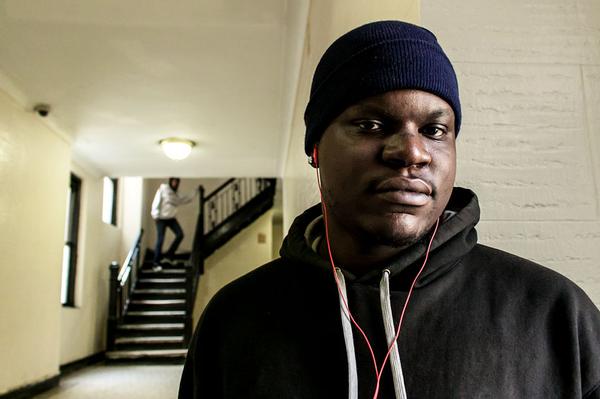
Photo by: Adi Talwar
For two years, Thomas Lee and his family have occupied a housing limbo: technically homeless, but residing in a Bronx apartment under the cluster program.
Thomas Lee, 26, opens the unlocked entry door at 220 E. 197th St. in the northwest Bronx, checks his mailbox and begins heading upstairs. With a wife and four kids in a one-bedroom apartment, he’s got a few things to do. For two years, Queens native Lee and his family have lived in this temporary space managed by Aguila, Inc., as part of the city’s contentious cluster site program, which is intended to house the homeless temporarily. Lee now has a job at Universal Survey in Manhattan and his wife is about to attend college. But until they can afford an apartment somewhere else, they aren’t going anywhere—meaning, officially, they are still homeless.
In the cluster site program (established by former Mayor Bloomberg in 2004 to follow a similar Giuliani administration program), the city provides at least $3,000 per apartment — more than two-and-a-half times the usual rent in many neighborhoods —to non-profit and for-profit companies that manage the units and oversee homeless tenants. These agencies are responsible for the share of the building occupied by the homeless and are supposed to help those residents, who aren’t formal tenants, find jobs and supply them with housing referrals.
Last year, Bronx Bureau reported on the concerns about the cluster-site program. Critics say the program is expensive and hurts low-income New Yorkers by essentially removing affordable apartments from the market. Regular tenants complain that landlords may try to push them out since they receive higher per-unit payments from the cluster program than from their usual renters.
Some advocates have faith that the new mayor is headed in a different direction.
Some signs of change
De Blasio and his homeless services commissioner, Gilbert Taylor, haven’t announced a new city cluster-site policy. And DHS declined to provide specific answers to questions about the program.
But DHS did say the mayor’s “overall change in philosophy has already started” to re-orient the city’s homeless policies. Among their changes, DHS has stopped discharging ineligible families, providing temporary shelter to those who reapply. Last Tuesday, the agency changed their family service policies and will now provide overnight accommodation to families denied shelter.
Reducing the reliance on the cluster program is easier said than done. The city’s $17.8 million contract with Aguila runs through June 2015. And because the city has a legal obligation to shelter all homeless people, it can’t scrap cluster-site without coming up with something else to take its place.
In March testimony Taylor said: “DHS is establishing a strategic plan to reduce shelter census with the goal of both preventing new shelter entries and by providing successful, permanent placements to those who are already in shelter.”
One reason the shelter census has breached 50,000 is the disappearance of the Advantage program, a housing subsidy that helped the Bloomberg administration move thousands of families out of shelters and into apartments. The program died in 2011 amid a dispute between the state and the city. In this year’s state budget, approved in March, the city won authority to design a new subsidy program for shelter residents. DHS is still designing that new approach.
”A complete disaster”
Cluster-site opponents probably won’t slap de Blasio on the back until he announces his plans, but one key advocate is feeling more positive than he did during the Bloomberg administration.
Last May, Patrick Markee, a senior policy analyst at Coalition for the Homeless, called the program called the program “a complete disaster.” With the new mayor, he expects a change in policy he says was “more than a decade in the making.”
“The good news is that, unlike the last mayor, they’re looking at restoring permanent housing resources for homeless families and children,” he says, adding that it will take time to achieve a full transition for a new policy. “The city may not be able to eliminate cluster-site shelter units right away. But by restoring permanent housing resources to help homeless families leave the shelter system, the city can begin to reduce the number of homeless families and, in the next few years, eliminate the use of cluster site units.”
Issued last month, the Coalition’s latest “State of the Homeless” report says that beyond the failure of cluster sites to help permanently house the homeless, the program’s cost to taxpayers is “well over three times the annual cost of a Section 8-style housing voucher for the same family.”
To get back to regular rents and reverse what advocates see as a costly crisis harming taxpayers and tenants, the Coalition recommends securing city and state rent subsidies “to allow families in ‘cluster site’ units that meet Section 8 quality standards to secure leases for the very apartments in which they already reside.”
Worry about Bronx impact
John Reilly, who has headed the Bronx nonprofit Fordham Bedford Housing Corporation for more than 30 years, is a strong proponent of pointing the city in another direction.
Though de Blasio is planning to announce his housing policy sometime in May, Reilly says he’s “been disappointed there is no new homeless rental program yet. This is not an easy fix and requires a lot of subsidy, so I’m concerned it could get kicked down the road for a while.”
Reilly, a lifelong Bronxite, is also concerned that the city has focused on the poorest borough for homeless programs. Of the cluster site buildings citywide, about 135 of 230 are in the Bronx, and he says more programs are coming.
“The city sending all the supportive housing and shelters to the Bronx is a growing issue and there will soon be some push back from ‘the outer borough,'” he says in an email.








